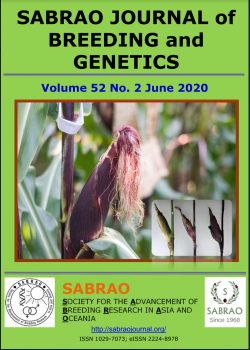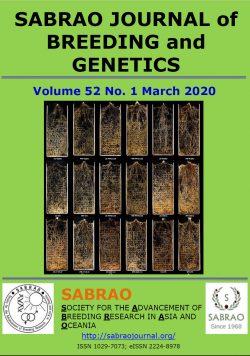
SABRAO JOURNAL of BREEDING and GENETICS ISSN 1029-7073; eISSN 2224-8978 Volume 52 Number 2 June 2020
This is the second issue of SABRAO for 2020. Click to view the new articles.

SABRAO JOURNAL of BREEDING and GENETICS ISSN 1029-7073; eISSN 2224-8978 Volume 52 Number 1 MARCH 2020
This is the first issue for the year 2020, featuring articles on corn, rice, sorghum and ground nut.
Testcross performance for anthocyanin and antioxidant activity in the ear components of purple waxy corn lines
Kalapakdee W, Dermail A, Lertrat K, Sanitchon J, S Chankaewi, Lomthaisong K, Surihari B
Published: June 2020
The anthocyanin and phenolic yields and antioxidant activity of seven waxy corn genotypes, their F1 progenies, and hybrid checks grown during two growing seasons in 2018–2019 were assessed. The mode of gene action on the traits of interest was investigated, and promising lines with high anthocyanin in whole-ear components were identified. An overwhelming dominance genetic effect, high reciprocal cross effects, and low heritability for targeted traits in corn husks and cobs were revealed. Promising lines, namely NSX/DKA/PF for corn husk anthocyanin content, PF/AB and S6248/TB/KND//PF for corn cob anthocyanin content, and PF/AB and TB/KND//PF for corn kernel anthocyanin content, were identified.
Download article
Kalapakdee W, Dermail A, Lertrat K, Sanitchon J, S Chankaewi, Lomthaisong K, Surihari B (2020). Testcross performance for anthocyanin and antioxidant activity in the ear components of purple waxy corn lines. SABRAO J Breed Genet 52(2):158–176.
Diversity and utilization of bamboo (Bambusoideae) in five islands around Riau Province, Indonesia
Fitmawati, Saputri NA, Hartanto S, Resida E, Kholifah SN, Kapli H, Sofiyanti N, Wahibah NN, Khairijon
Published: June 2020
The diversity and functions of bamboo in peatlands were determined. Five genera, 17 species, and three varieties were identified and delineated into two groups. The most closely related species were Bambusa vulgaris Schard. Ex Wendl. var. striata and B. vulgaris Schard. Ex Wendl. var. vulgaris, whereas the most distantly related species were Gigantochloa kuring Widjaja and Gigantochloa atter (Kurz). Bamboo had 21 types of uses and is generally used as a soil-retaining plant and a clean-water filter. B. vulgaris Schard. Ex Wendl. var. vulgaris had multiple purposes and showed adaptability to all types of habitats. This species has the potential to be developed in peatland areas.
Download article
Fitmawati, Saputri NA, Hartanto S, Resida E, Kholifah SN, Kapli H, Sofiyanti N, Wahibah NN, Khairijon (2020). Diversity and utilization of bamboo (Bambusoideae) in five islands around Riau Province, Indonesia. SABRAO J Breed Genet 52(2):177–190
Starch accumulation of cassava genotypes grown in paddy fields during off-season
Nimlamai T, Banterng P, Jogloy S, Vorasoot N
Published: June 2020
Starch production by four different cassava genotypes grown in four different upper paddy fields during the off-season of rice was studied. Early storage root formation, rapid starch production rate, and high starch yield accumulation were identified as relevant traits top-yielding cassava genotypes in off-season rice paddy systems. CMR38-125-77 was identified as a satisfactory cassava genetic resource.
Download article
Nimlamai T, Banterng P, Jogloy S, Vorasoot N (2020). Starch accumulation of cassava genotypes grown in paddy fields during off-season. SABRAO J Breed Genet 52(2):109–126.
Identification of the secondary metabolite capsiate in Capsicum germplasm accessions.
Tarinta T, Chanthai S, Lertrat K, Nawata E, Techawongstien S
Nineteen pepper accessions were evaluated for high capsiate levels without capsaicin. The presence of capsiate and capsaicin were evaluated by using two DNA markers. The KKU-P31146 accession showed the highest capsiate levels without capsaicin and could be used as a new source for breeding high-CAT accessions.
Tarinta T, Chanthai S, Lertrat K, Nawata E, Techawongstien S (2020). Identification of the secondary metabolite capsiate in Capsicum germplasm accessions. SABRAO J Breed Genet 52(2):144–157.
GENETIC DIVERSITY, PRODUCTION, AND TRADE OF CHILI WITH SPECIAL REFERENCE TO NEPAL
D. POUDYAL, P. POUDYAL, B.K. JOSHI, S.M. SHAKYA, K.P. SINGH, and K.C. DAHAL
Citation: Poudyal D, Poudyal P, Joshi BK, Shakya SM, Singh KP, Dahal KC (2023). Genetic diversity, production, and trade of chili with special reference to Nepal. SABRAO J. Breed. Genet. 55(1): 1-14. http://doi.org/10.54910/sabrao2023.55.1.1.
Summary
Chili is a popular spice crop in Nepal, a country with countless genetic diversity and a wider distribution covering areas from the tropics to the warm temperate regions. However, the exploitation of chili’s genetic potential to improve yield has faced challenges by different factors. An analytical study on genetic diversity, production challenges, and marketing opportunities of chili was still lacking in Nepal. This study aims to provide information on chili diversity, its distribution, and uses in Nepal, discussing the potential role of chili in Nepalese agriculture. Mainly, the study is a desk review complemented with a field study. Total chili production increases with an increasing area under cultivation over the years. In 2021, chili production covered 23,083 ha, 13% higher than in 2020. Per capita chili consumption is estimated at 9.8 kg in 2021. Diversity in chili phenotypes grown in the study area of Nepal has been noted. On a nine-point scale, higher variations showed in fruit traits (5 ± 1.5), floral morphology (4 ± 0.8 distinct types of flowers), leaf size (3 ± 0.7), plant height (3 ± 0.8), and maturity (3 ± 0.8) among chili genotypes in the area studied. Insect pests (15.6%) and diseases (16.4%) emerged as the main problems in chili cultivation, followed by drought stress (14.8%) and a shortage of fertilizers (10.1%). Marketing-related issues shared 2.7% among the 12 main concerns, particularly farmers who suffered more from inadequate market information. In addition, estimates on seed requirements, seed sources, existing chili varieties, and market segments also gained focus. The need for demand-based action research to strengthen Nepalese chili production and marketing proves imperative to fulfill the growing domestic demand and export potential.
Keywords: biotic and abiotic stress; chili production issues; hot pepper; phenotypic markers; and phenotyping
Key findings: Nepal is rich in chili genetic resources, with records of notable phenotypic variations for fruit traits (average of five distinct shapes, sizes, and orientations in seven studied locations), for flower characters (average of four different colors and orientations), for leaf characters (average of three distinct sizes), for plant height (three different heights), and maturity (three levels of maturity) during the field study. Chili serves as the most significant spice crop in Nepal. The total area coverage and chili production increased over the years. In 2021, a larger area of more than 23,000 ha gained cultivation, producing nearly 184,900 MT and a per capita consumption estimated at 9.8 kg. The main culprits of the low productivity (8 ± 0.3 MT/ha) of chili in the country consist of biotic factors (insect pests and pathogens) (49%), abiotic factors (drought stress and fertilizer shortage) (40%), and managerial limitations (11%).
SABRAO Journal of Breeding and Genetics
55 (1) 1-14, 2023
http://doi.org/10.54910/sabrao2023.55.1.1
http://sabraojournal.org/
pISSN 1029-7073; eISSN 2224-8978
Date published: February 2023
« Back to main page of SABRAO Journal of Breeding and Genetics Vol. 55 No. 1